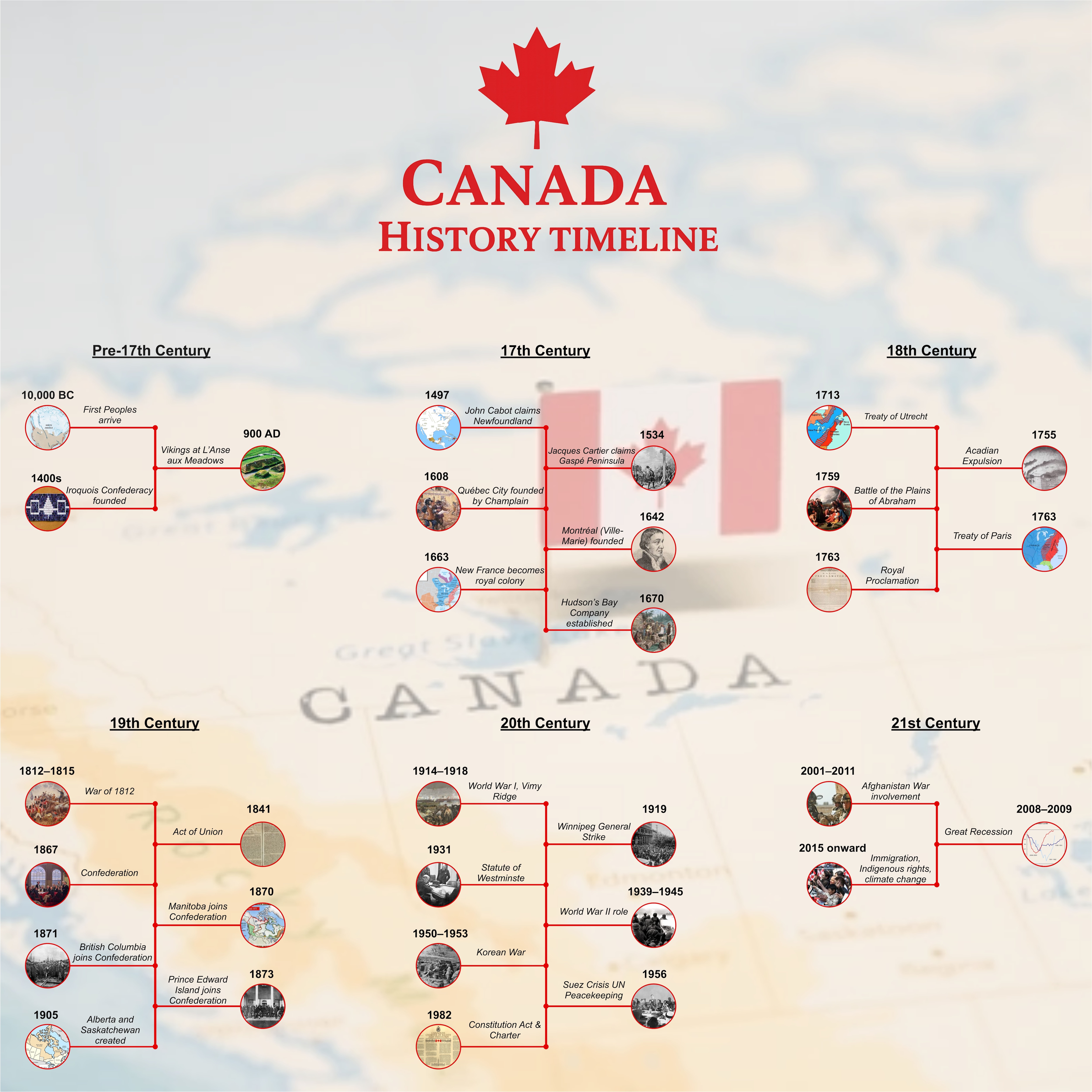Canada’s history is not simple… in any sense of the word. It’s more like a chain of one decision after another, clashes, and experiments for the people’s survival. Every event left a mark that pushed the next one forward. People arrived, settled, traded, and fought. Empires took turns ruling, Indigenous nations resisted and adapted, and new communities kept forming.
Sometimes decisions were practical, sometimes they were messy, and sometimes they were simply about survival. Looking back, it’s easier to see the connections between these turning points. Each date in this timeline isn’t random. Every event sets the stage for what follows. Let’s take a peek at the key events in the timeline to understand the bigger picture.
Canada History Timeline
Pre-17th Century
10,000 BC
After the Ice Age, the first peoples arrived in Canada. Crossing from Asia. They adapted quickly to forests, rivers, and coasts. Building cultures tied to the land. These societies weren’t static; they traded, hunted, and created traditions that remain alive till today. This was where Canada’s roots started.
900 AD
Norse explorers (Vikings) from Greenland landed in Newfoundland at L’Anse aux Meadows. They built simple dwellings and left artifacts, but their stay was short. Conflicts with Indigenous groups and the harsh environment ended their plans. Still, this visit mattered: it was Europe’s first contact with North America, centuries before permanent settlements.
1400s
In the Great Lakes region, several indigenous nations united into a powerful alliance. That was called the Iroquois Confederacy. Their governance system was sophisticated. Balancing collective decisions and individual voices. This alliance strengthened Indigenous communities in diplomacy and warfare. By the time Europeans arrived, the land was already home to complex political systems and strong leadership.
17th Century
1497
Italian explorer John Cabot, sailing for England, reached Newfoundland. His journey didn’t spark immediate colonization. However, it revealed rich fishing waters that attracted the Europeans’ interest. These early expeditions set England’s claim in motion, even if settlers wouldn’t arrive until much later. Cabot’s voyage planted England’s first flag in North America.
1534
Cartier sailed for France, exploring the Gulf of St. Lawrence. He raised a cross at Gaspé, symbolizing France’s claim. Indigenous peoples he met, of course, had their own view. Seeing him as a guest, not an owner. This encounter opened centuries of negotiation, trade, and often tension between France and First Nations.
1608
Samuel de Champlain established Quebec City, a strategic hub on the St. Lawrence River. It became France’s anchor in North America. Trade with Indigenous peoples, especially in furs, kept it alive. Quebec wasn’t just a colony; it was the heart of New France’s survival and France’s foothold overseas.
1642
Missionaries and settlers created Ville-Marie, later Montreal. They founded it with hopes of spreading Christianity and expanding trade. Its location made it ideal for commerce, but also vulnerable to attacks. Over time, Montreal grew into a major center, bridging Indigenous trade networks and French colonial ambitions in North America.
1663
France took direct control of New France, ending company rule. The king sent administrators, soldiers, and settlers to strengthen it. This change gave the colony stability, though it remained small compared to Britain’s holdings. France’s commitment deepened, setting the stage for growing rivalry with England in North America.
1670
Britain chartered the Hudson’s Bay Company, granting control of a vast northern territory. It built forts and traded furs, competing directly with New France. This company wasn’t just about trade. Because in reality, it was about empire-building. The rivalry with France for Indigenous alliances and resources was now locked in for good.
18th Century
1713
The Treaty of Utrecht ended the War of Spanish Succession, with France ceding Acadia to Britain. This reshaped the balance of power in North America. Acadian families suddenly found themselves under new rulers. Britain gained territory, but also inherited populations that resisted English authority and clung to French traditions.
1755
British authorities expelled thousands of Acadians, scattering them to American colonies, France, and Louisiana. Families were broken apart, homes destroyed. The expulsion aimed to eliminate resistance, but instead became a lasting tragedy. The displacement of the Acadians remains one of the most painful episodes in Canadian history.
1759
On the fields outside Quebec City, French and British forces clashed. That event is remembered as the Battle of the Plains of Abraham. Britain’s victory ended French control in Canada. It was short but decisive. Soldiers on both sides fought hard, but the outcome reshaped the continent’s authority. France’s defeat paved the way for full British dominance in North America.
1763
The Treaty of Paris confirmed Britain’s control over New France. That same year, the Royal Proclamation set rules for colonization and recognized Indigenous land rights. On paper, it looked fair, but settlers often ignored it. Britain had won an empire, but it also inherited new conflicts to manage.
19th Century
1812–1815
Britain and its colonies fought against the United States in 1812. Canadian militias, Indigenous allies, and British troops pushed back invasions. Though the war ended in a stalemate, it built confidence among Canadians. The battles proved they could defend their land. Planting seeds of a shared Canadian identity in their hearts.
1841
The Act of Union merged Upper and Lower Canada into one province. Hoping to reduce unrest. Instead, it deepened cultural tensions between English and French Canadians. The arrangement created constant political battles. It highlighted the difficulty of governing diverse communities under one system. Something Canada still grapples with to this day.
1867
On July 1, four provinces – Ontario, Quebec, New Brunswick, and Nova Scotia united to form the Dominion of Canada. The deal was practical: shared defense, trade, and infrastructure. It wasn’t about creating a perfect nation, but about survival. The Confederation was cautious, and in a way, Canada’s first true government.
1870–1873
Canada’s expansion followed quickly. Manitoba joined in 1870, BC in 1871, and PEI in 1873. Each came with conditions – railways, debt relief, or land promises. For Indigenous peoples, though, these deals meant more loss of land and autonomy. Even more than they were already facing. Canada grew larger, but at a cost rarely acknowledged at the time.
1905
Canada carved out two new provinces from the prairies, Alberta and Saskatchewan. Settlers had been flooding in, and Ottawa wanted order. The move strengthened Canada’s presence in the West. For newcomers, it was an opportunity. For Indigenous communities, it marked yet another stage of displacement under government control.
20th Century
1914–1918
Canada fought under Britain’s banner in World War I. Sending thousands overseas. At Vimy Ridge in 1917, Canadian troops succeeded where others had failed. Like all victories, it cost many lives. but boosted national pride. Soldiers came home changed. Canada emerged with a stronger sense of itself, though it was grieving heavy losses.
1919
After the war, workers faced inflation and poor conditions. In Winnipeg, 30,000 people walked off the job, causing a general strike. For six weeks, the city nearly shut down. Authorities cracked down, but the strike showed ordinary Canadians were ready to demand fairer wages and working rights.
1931
The Statute of Westminster gave Canada legal independence in most matters. Britain could no longer impose laws. This marked a big step toward sovereignty, even though Canada still kept ties. It was quiet compared to battles or treaties, but it still mattered. It confirmed Canada’s step towards becoming a separate state and no longer just a colony.
1939–1945
Once again, Canada joined Britain in World War II. Over a million Canadians served. They fought in Europe, at sea, and in the air. The war transformed Canada’s economy and international role. The sacrifice was immense, but by the end, Canada had earned recognition as a serious player on the world stage.
1950–1953
Canada joined the United Nations forces in Korea, sending soldiers to fight in a distant land. It wasn’t a global war like the two before. But it showed Canada’s commitment to collective defense. The experience also strengthened Canada’s role in international peacekeeping during the Cold War era.
1956
During the Suez crisis in Egypt, Canada proposed the creation of UN peacekeepers. The idea, led by Lester B. Pearson, helped ease tensions. It gave Canada a reputation as a mediator. This was a proud diplomatic moment. Proof that Canada could make global contributions beyond fighting wars.
1982
Canada patriated its Constitution, bringing it fully under Canadian control. The Charter of Rights and Freedoms gave citizens stronger protections. It was a turning point. Canada had its own legal backbone at last. The process wasn’t smooth, but it cemented independence for Canada. Something that was long in the making.
21st Century
2001–2011
Canadian soldiers served in Afghanistan for a decade. As a part of NATO forces. The mission was tough. Again, many lives were lost on both sides, and debates over its purpose continue today. It marked Canada’s longest war.
2008–2009
Then the Great Recession happened. The financial crisis hit globally. Canada avoided the worst. But families were still struggling with jobs and savings. The government had to step in with support measures. The recession highlighted how connected Canada’s economy was to the world. And how vulnerable people were to decisions made far away.
2015 Onward
The recent years have brought new challenges. Canada’s unique landscape is struggling with climate change. And finally, after so many years of suppression, the Indigenous people are starting to get their rights back. Reconciliations are ongoing, with calls for justice and truth. Canada also faces global shifts in politics and trade. We can say that these aren’t battles of armies, but struggles of responsibility. And it is high time that every country starts to do the same to build a fairer world.
How to Make a Similar Timeline in EdrawMax?
Canada’s history is built on countless turning points and sacrifices. It’s been quite the ride for Canada. But the best thing about its people is that they own up to their history and are proud of it. And yes, it all fits neatly into a timeline.
Don’t worry if you’ve never made one before. EdrawMax, a helpful timeline maker, keeps things simple. Drag, drop, and boom… you’ll be making timelines like a pro.
Let’s start creating:
Step1Install EdrawMax
- First things first, download EdrawMax to your computer.
- Log in with your Wondershare account – or create one if you’re new to get started.
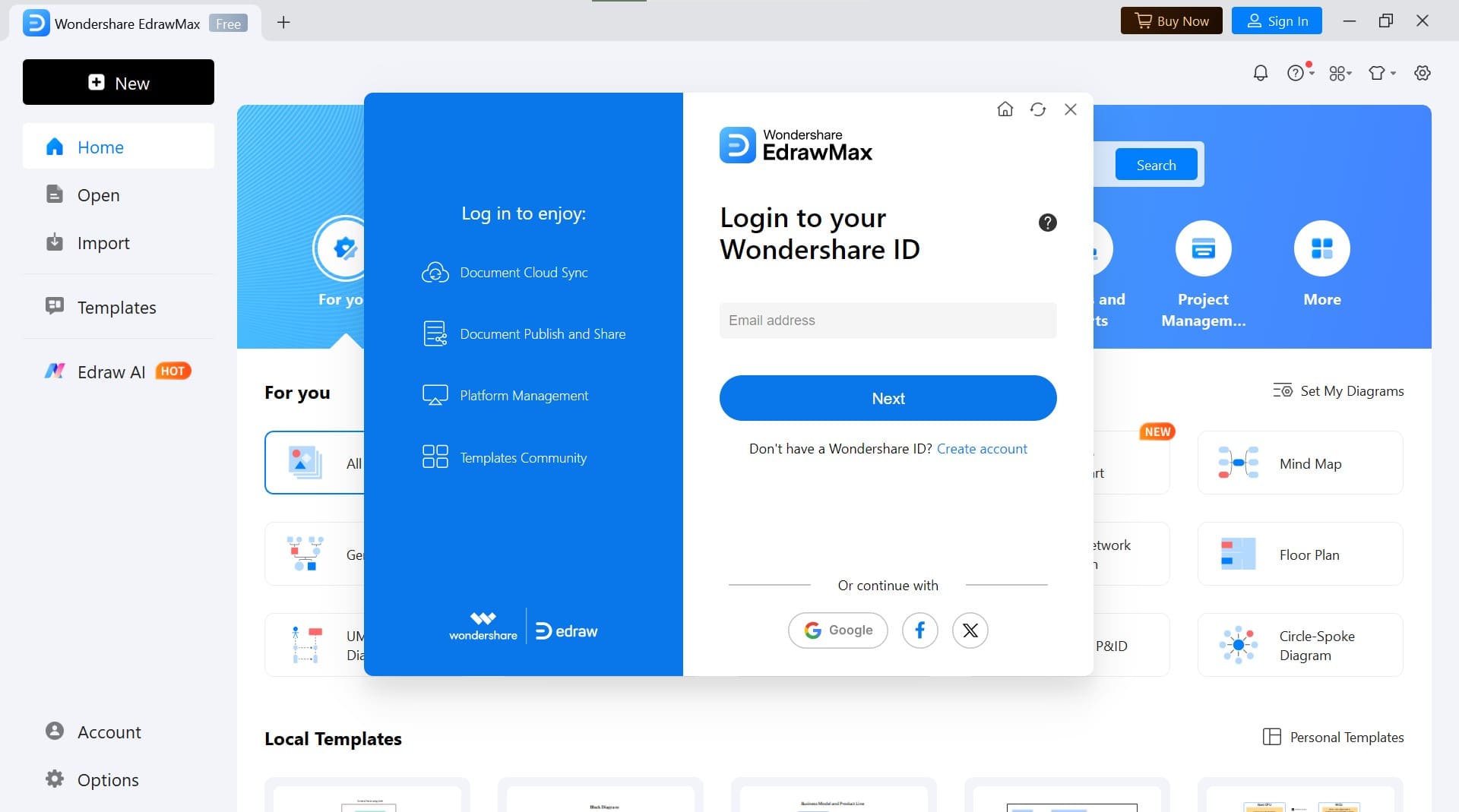
Step2Start a Timeline Project
- On the homepage, go to Basic Diagram > Timeline > Blank Drawing to open a fresh canvas.
- Short on time? Browse the ready-made templates instead.
- For now, we’ll learn to build a new timeline from scratch.
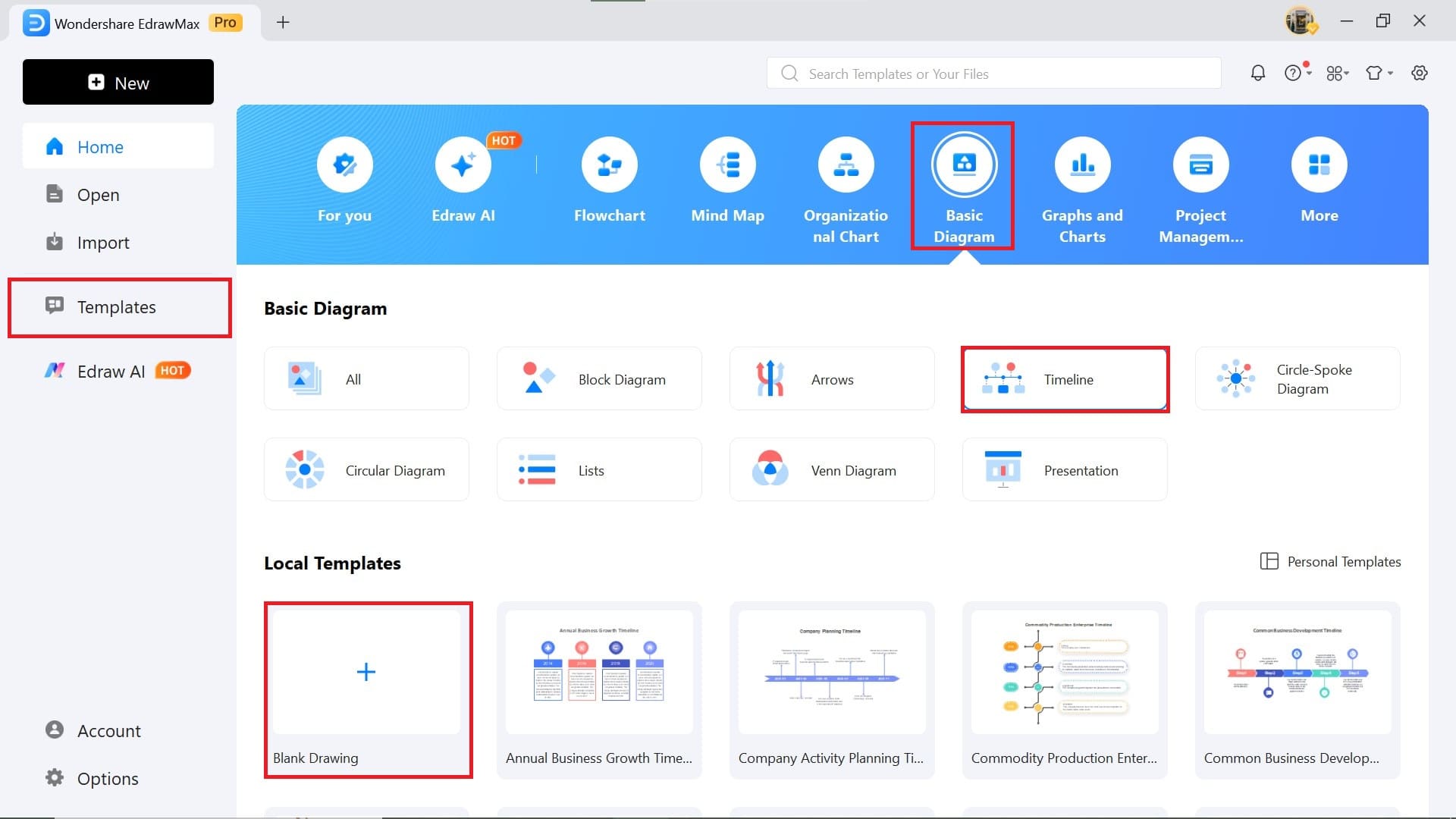
Step3Choose a Layout
- Click Symbols on the left-side panel.
- Drag and drop a timeline style that suits your project.
- For this particular timeline, you’ll need six separate layouts.
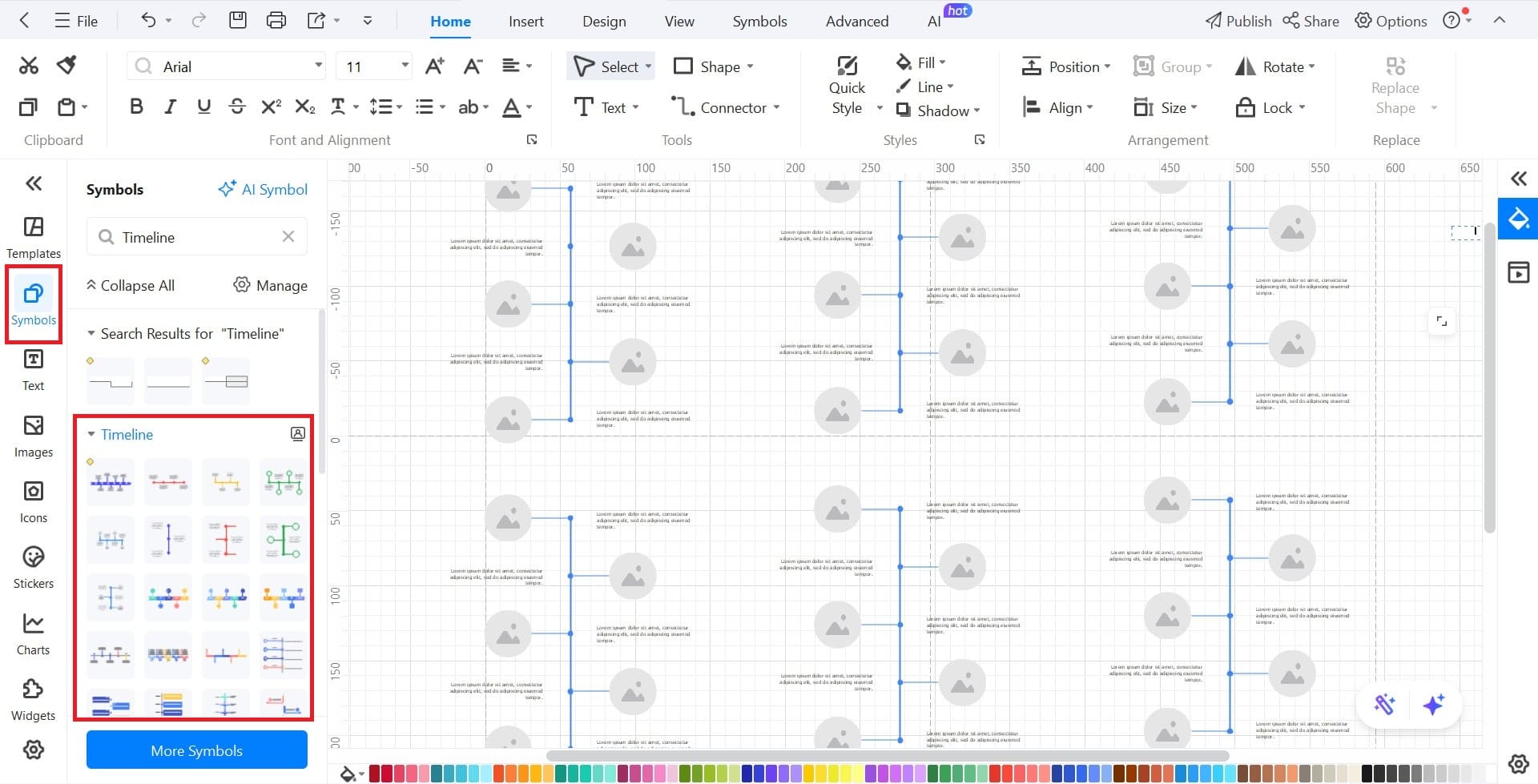
Step4Customize the Timeline
- Click on your timeline to open the editing toolbar.
- Use Number to add or remove divisions.
- Adjust Picture Size for image frames.
- Change Horizontal Interval to space events evenly.
- Need text? Drag and drop boxes from the Text section.
- Edit the text through the Text Format panel or Home bar.
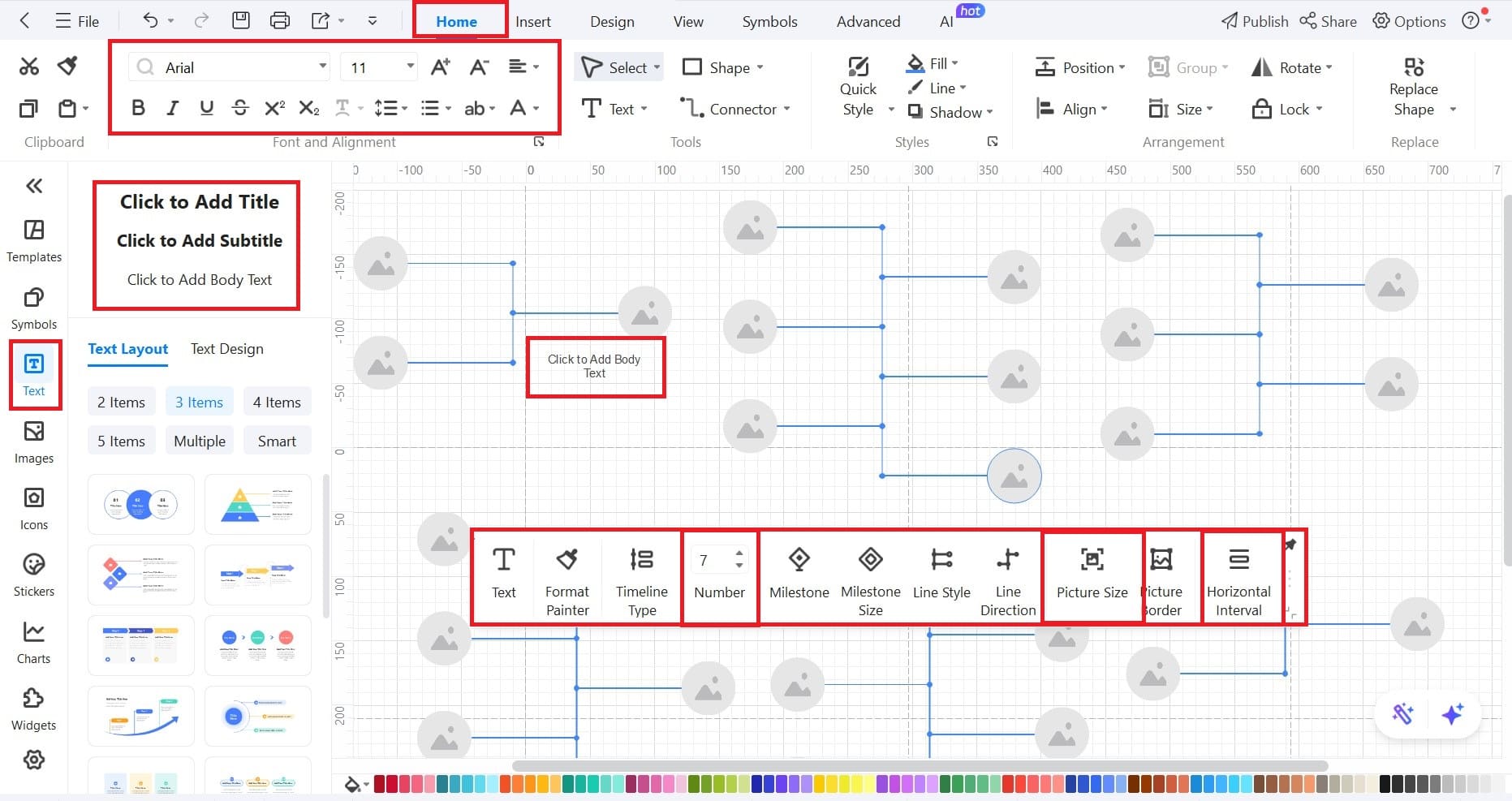
Step5Style it your Way
- Select the timeline and play with colors using the quick color bar.
- Add images through Insert > Picture > Local Pictures.
- Want a background? Go to Design > Background Picture or upload your own.
- Click and choose Send to Back to position it behind your timeline.
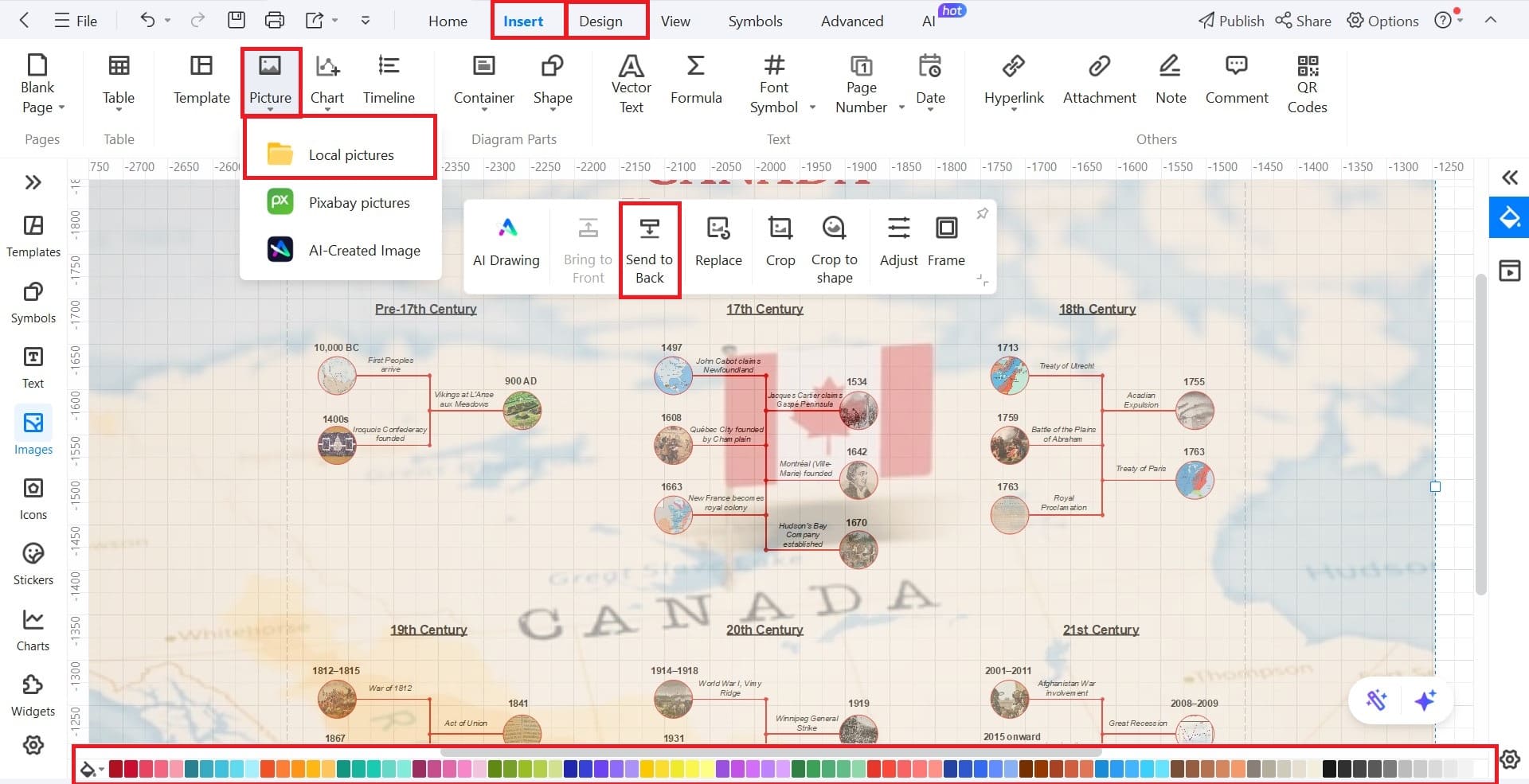
Step6Save and Export
- When you’re happy with your design, click the Export icon in the quick toolbar.
- Pick your preferred format and export.
- To share, hit the Share button, generate a link, and set its visibility. Done!
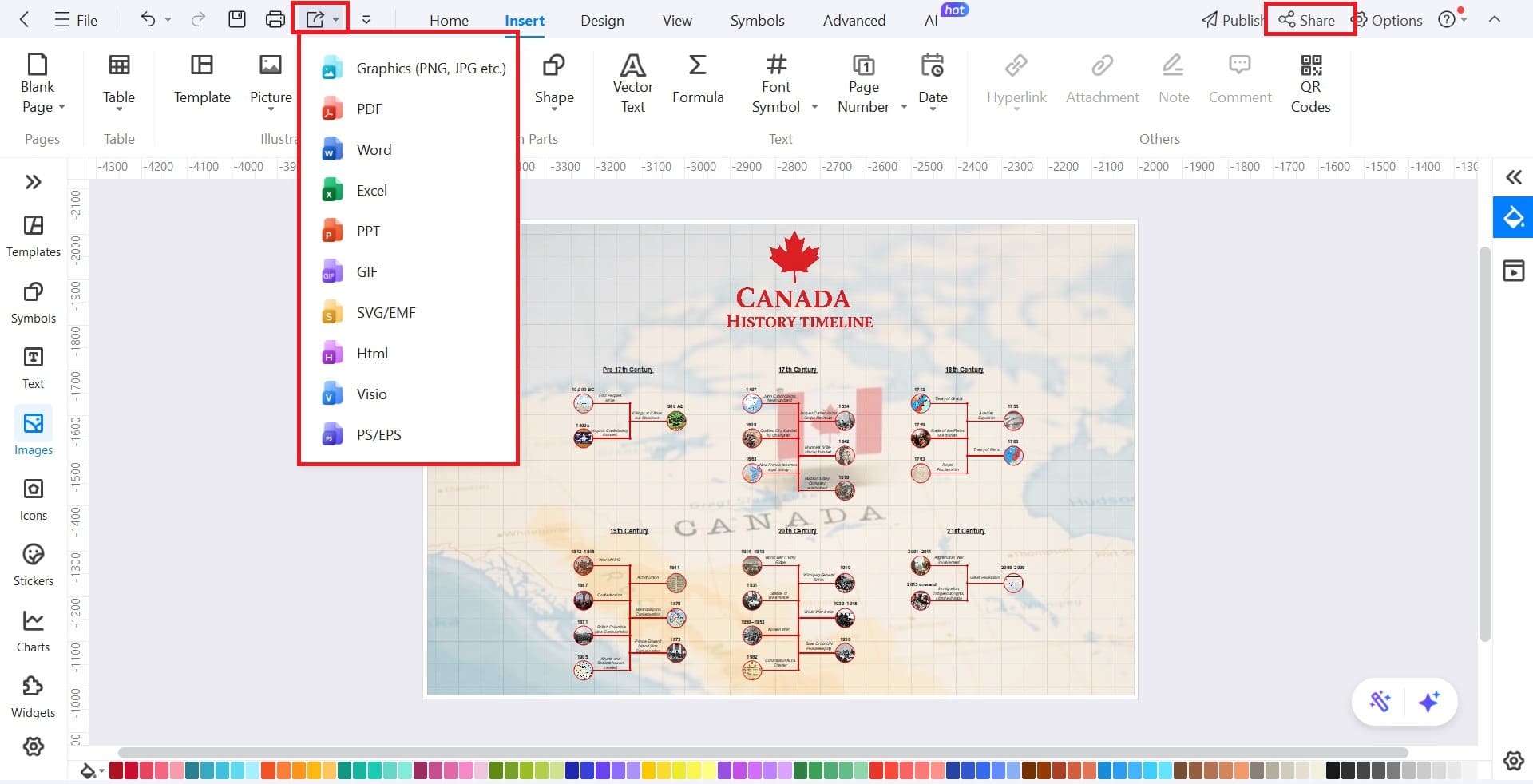
Ending Notes
And that’s Canada’s story in a nutshell. Centuries of indigenous roots to modern milestones shaping a huge nation. It’s remarkable to think how each twist of history contributed to making the Canada we know today.
The best part? You can lay it all out yourself. Grab EdrawMax and create your own timelines. Ensure all those dots of history come together, forming a story to remember.




